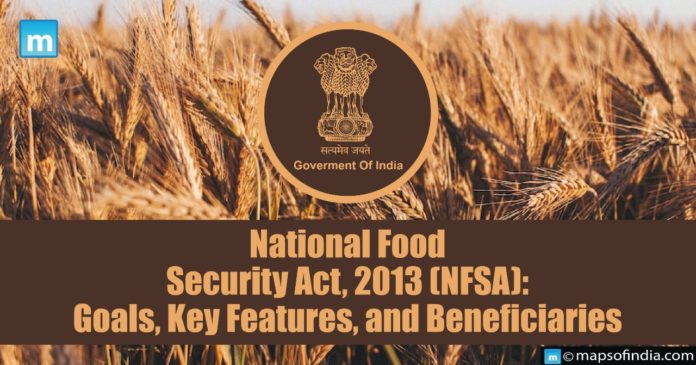National Food Security Act (NFSA) 2013, approved on July 5, 2013, represents a paradigm shift in food security by shifting from welfare to rights-based approaches.
Key Features of the National Food Security Act:
- Under the National Food Security Act, households eligible for the Priority Families Program (PHP) and the Antyodaya Anna Yojana (AAY) receive 35 kg of food grains per month (5 kg per person).
- Each kilogram of rice, wheat, and coarse grains costs Rs. 3, Rs. 2, and Rs. 1, respectively.
- The prices of foodgrains have not been changed in the Union Budget 2022. Rice, wheat, and coarse grains would continue to be offered at the PDS Issue rates of Rs. 3, Rs. 2, and Re. 1 per kg, respectively.
- The Act became law on September 12, 2013, going back to July 5, 2013.
Aim:
With a focus on ensuring food and nutritional security throughout the human life cycle, the Act guarantees that people have access to a sufficient amount of high-quality food at affordable prices for them to live dignified lives and for items related to or incidental to those lives.
Following is a description of the Act’s main features:
Coverage
- The NITI Aayog calculated the state-by-state coverage using data from the NSSO’s 2011–12 Household Consumption Expenditure Survey.
- Under the Targeted Public Distribution System, the Act allowed up to 75% of the rural populace and 50% of the urban population to get subsidised food grains (TPDS).
- Therefore, the Act includes almost two-thirds of the populace to get heavily subsidised food grains.
Benefits:
- Under the Public Distribution System, food grains would be offered at significantly discounted rates.
- The Act guarantees women’s and children’s nutritional support. The MDM and ICDS programmes would grant pregnant and nursing women the right to complimentary, nutrient-dense meals.
- Under the MDM and ICDS programmes, kids between 6 and 14 would also be eligible for free, nutrient-dense meals.
- Pregnant and breastfeeding mothers are also given maternity benefits of at least Rs. 6000.
- The Act further empowers women by designating the eldest female household member as the home’s head and authorising them to issue ration cards.
- The Central Government manages the Fair Price Shop (FPS) dealers’ margins by the standards and assists the States in covering the costs paid by them for the delivery of foodgrains within the State.
- The recipients are given a food security allowance if food grains are not supplied.
- Transparency: To ensure transparency, provisions have been developed for disclosing PDS-related documents.
Beneficiaries of NFSA:
Under two main categories of beneficiaries, the Law cover two-thirds of the whole population:
- Households under the Antyodaya Anna Yojana (AAY)
- Priority Families (PHH)
AAY households are those headed by widows, disabled people, or those 60 years of age or more without a guaranteed source of assistance from society. Typically, it also considers the households of people who live in poverty. Assistance for women and children is also included.
People who live in eligible homes, or PHHs, are granted the privilege to receive food grains at discounted costs by the NFSA. This group includes a sizable portion of priority sector ration cardholders. This is an initiative to combat poverty.




